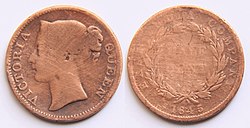This article needs additional citations for verification .(September 2022) |

The cent is a monetary unit of many national currencies that equals a hundredth (1⁄100) of the basic monetary unit. The word derives from the Latin centum, 'hundred'.
Contents
- Symbol
- North American cent sign
- Orthography
- Usage
- Minor currency units called cent or similar names
- Minor currency units with other names
- Obsolete centesimal currency units
- See also
- References
The cent sign is commonly a simple minuscule (lower case) letter c. In North America, the c is crossed by a diagonal or vertical stroke (depending on typeface), yielding the character ¢.
The United States one cent coin is generally known by the nickname "penny", alluding to the British coin and unit of that name. Australia ended production of their 1c coin in 1990, [1] New Zealand last produced their 1c coin in 1988, [2] as did Canada in 2012. [3] [4] Some Eurozone countries ended production of the 1 euro cent coin, most recently Slovakia in 2022. [5]
